Cantor dust fractal
World's simplest fractal tool
This utility lets you draw custom and colorful Cantor dust fractals. We have created three types of fractal – Regular Dust, Connected Dust, and Dusty Dust. They're all based on the Cantor set principles that are extended to two dimensions and differ in the presence or absence of additional central squares. For each of these types, you can set the number of recursive steps and the reduction ratio of square sizes between the recursions. You can also adjust the working space by setting the values for its height, width, padding, and square properties. We offer a palette of four colors to choose for the dust's outline, background, side and center squares. Fun fact – Cantor dust is just a Cartesian product of the Cantor set with itself and can be extended to three-dimensional space and beyond by calculating more products. Created by fractal fans from team Browserling. Fractabulous!
Check out our main project!
Browserling
We created Browserling – get a cloud browser in 5 seconds. Check it out!
A link to this tool, including input, options and all chained tools.
Can't convert.
What is a cantor dust fractal?
learn more about this tool
This online browser-based tool illustrates Cantor dust fractals. The idea behind building this fractal is to apply the middle-thirds Cantor set to a square in two-dimensional space. This is accomplished by dividing a square into nine equal-sized parts and leaving only the four side squares (and depending on the fractal type, additionally leaving the central square, too). To construct the "Regular Dust" type, we remove the central square, leaving only 4 squares in the corners. At the nth iteration step, this fractal yields 4ⁿ⁻¹ squares with sides rⁿ⁻¹ times smaller than the starting square. The variable r is the reduction ratio that can be adjusted in the options. To create the "Connected Dust" type, we leave an additional square in the center from iteration to iteration. For this type, (4ⁿ-1)/3 squares are drawn at the nth iteration step. In the "Dusty Dust" type (also known as the "Box Fractal"), we leave not only the central square but also grind it to dust. By doing this, at the nth recursion level, we get 5ⁿ⁻¹ squares. Just like Cantor set, Cantor dust has zero measure. Mind blowing and ingenious at the same time, or as we love to say – fractabulous!
Cantor dust fractal examples
Click to useRegular Cantor Dust Fractal
In this example, we generate a regular Cantor dust fractal of the 4th order. The iterative order tells us that there are 4⁴⁻¹ = 4³ = 64 squares shown here with sides 3⁴⁻¹ = 3³ = 27 times smaller than the side of the initial square. We use a 600x600px canvas, fill it with a gorse-yellow color, and draw green dust with a deep-fir color outline.
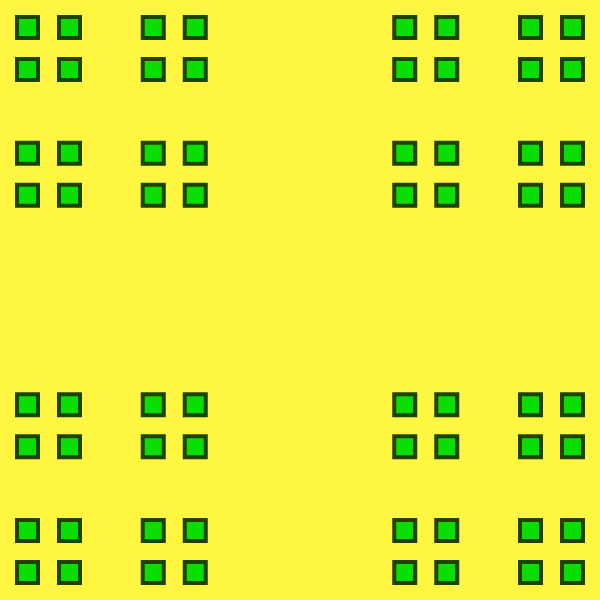
Required options
Draw the textbook version
of a Cantor dust fractal.
Reduction ratio of the square
sides between iteration steps.
Color for space fill.
Color for side dust fill.
Color for dust outline.
Dust outline width.
Number of iterative steps.
Space width.
Space height.
Extra space around all dust.
Connected Cantor Dust
This example illustrates a four-color version of the Connected Dust fractal. It recurses three times on an 800x800px canvas with 20-pixel padding and produces 21 vertex-to-vertex connected squares of various sizes. It uses a Klein-blue color for the background, pink-flamingo color for the four side squares, yellow color for the central squares and black for the square outline.
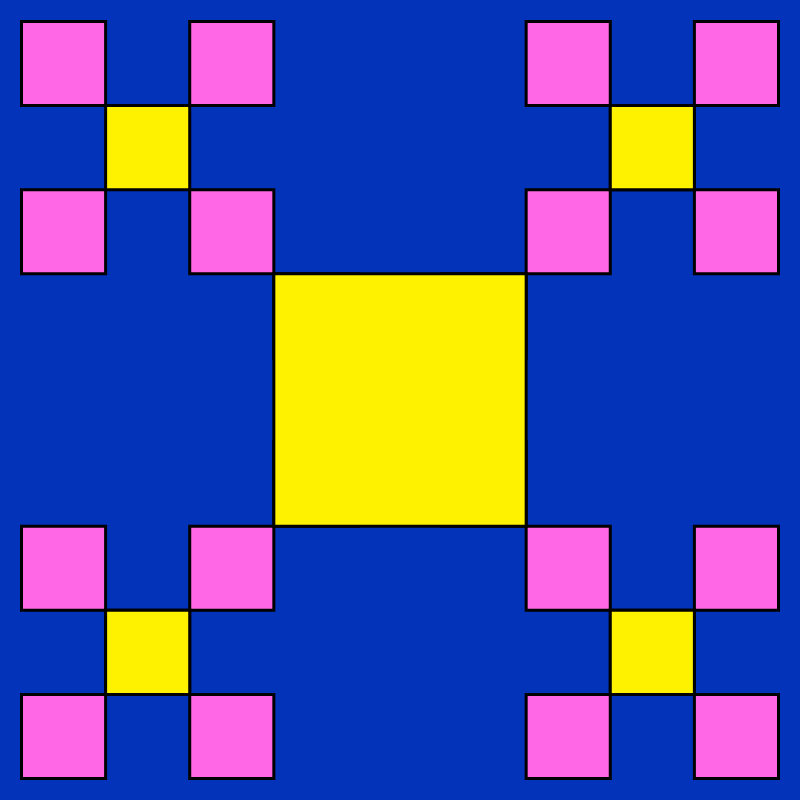
Required options
Draw a Cantor fractal with
extra squares in the center
and all squares touching
by vertices.
Reduction ratio of the square
sides between iteration steps.
Color for space fill.
Color for side dust fill.
Color for central dust fill.
Color for dust outline.
Dust outline width.
Number of iterative steps.
Space width.
Space height.
Extra space around all dust.
Cantor Box Fractal
In this example, we create the Dusty Dust fractal at the 4th iteration stage. This fractal type grinds the initial square into a fine powder. The construction of this fractal is the same as the Box Fractal with the starting square crushed to 125 congruent squares, each 729 times smaller in area than the initial square. The formula used to calculate the total number of squares is 5ⁿ⁻¹ = 5⁴⁻¹ = 5³ = 125, and the formula to calculate the area ratio of the start square to a single final square is r²⁽ⁿ⁻¹⁾ = r²⁽⁴⁻¹⁾ = r⁶ = 3⁶ = 729.
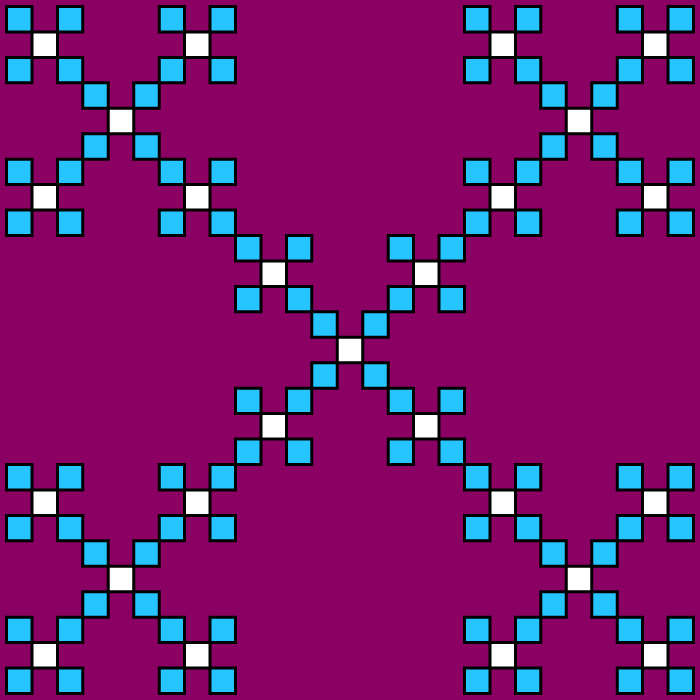
Required options
Draw a Cantor fractal with
extra squares in the center
crushed to fine dust.
Reduction ratio of the square
sides between iteration steps.
Color for space fill.
Color for side dust fill.
Color for central dust fill.
Color for dust outline.
Dust outline width.
Number of iterative steps.
Space width.
Space height.
Extra space around all dust.
1024 Dust Particles
In this example, we set the reduction ratio to 2.4 and generate the textbook version of the Cantor dust fractal. We recursively chop the unit square to the depth of six, which produces 4⁶⁻¹ = 4⁵ = 1024 particles. As with every recursive step, the side of new squares decreases 2.4 times, then at depth six, the side of the smallest dust particle is 2.4⁶⁻¹ = 2.4⁵ ≈ 79 times smaller than of the original square. The white dust particles are drawn on a laurel-green color canvas, which is 800x800px in size.
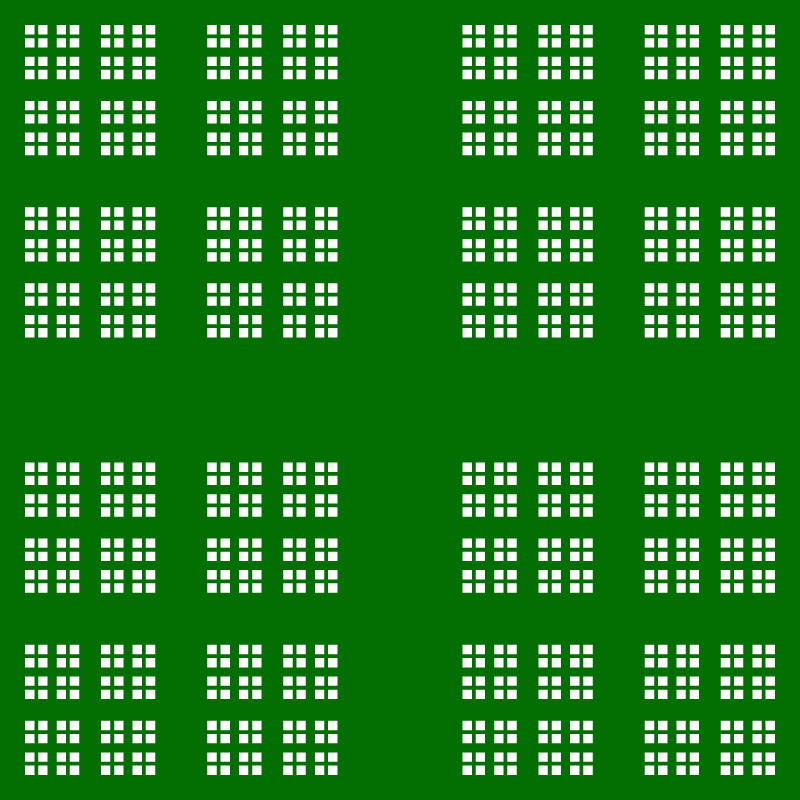
Required options
Draw the textbook version
of a Cantor dust fractal.
Reduction ratio of the square
sides between iteration steps.
Color for space fill.
Color for side dust fill.
Color for dust outline.
Dust outline width.
Number of iterative steps.
Space width.
Space height.
Extra space around all dust.
Crosslike Dusty Dust Fractal
This example draws a Dusty Dust fractal with the reduction ratio equal to 4. At the 5th iteration, the area of the tiniest squares in the corners is r²⁽ⁿ⁻¹⁾ = 4²⁽⁵⁻¹⁾ = 4⁸ = 65536 times smaller than the first square. As the central squares serve as connections for the others, their size is slightly larger than the corner squares. This fractal configuration resembles a cross or diffraction spikes that you see in astronomy photos.
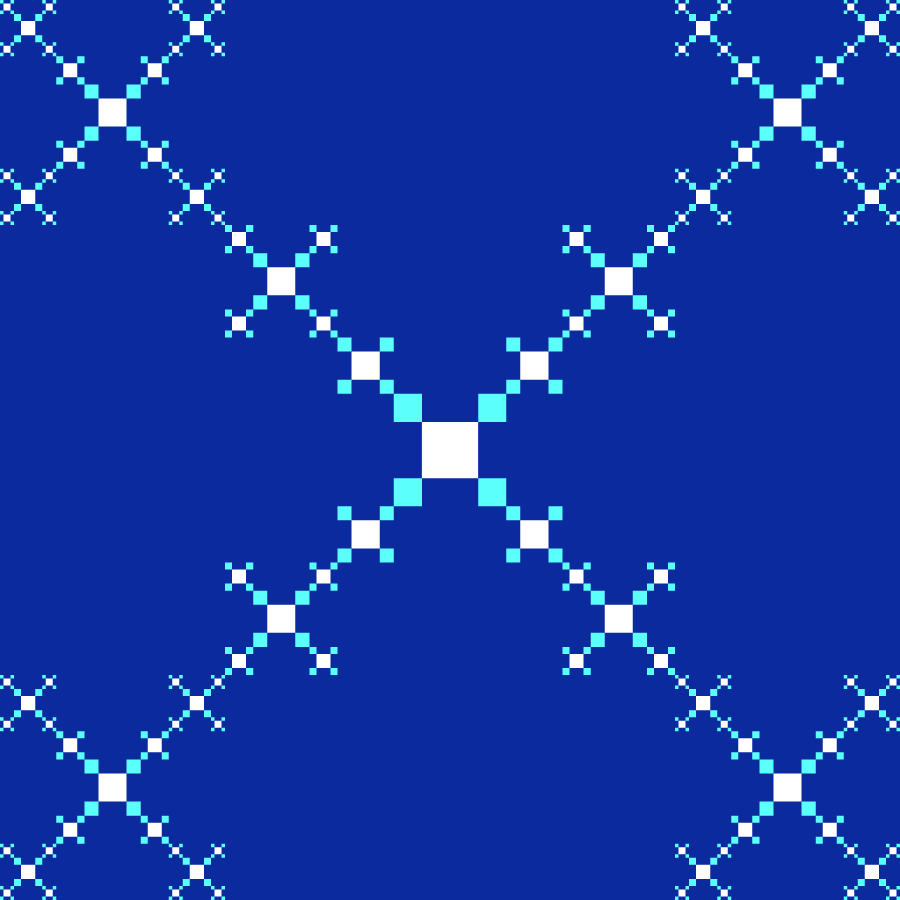
Required options
Draw a Cantor fractal with
extra squares in the center
crushed to fine dust.
Reduction ratio of the square
sides between iteration steps.
Color for space fill.
Color for side dust fill.
Color for central dust fill.
Color for dust outline.
Dust outline width.
Number of iterative steps.
Space width.
Space height.
Extra space around all dust.
Bright Connected Dust Fractal
In this example, we set the side-to-side ratio to 2.2 and generate a bright fourth-order Connected Dust fractal. With these options, the side of the red squares is 2.2⁴⁻¹ = 2.2³ ≈ 10 times smaller than the side of the initial square. Yellow squares connect the red squares together and have different sizes at different recursive levels. We also add 15-pixel padding and draw the dust on a cyan color background.
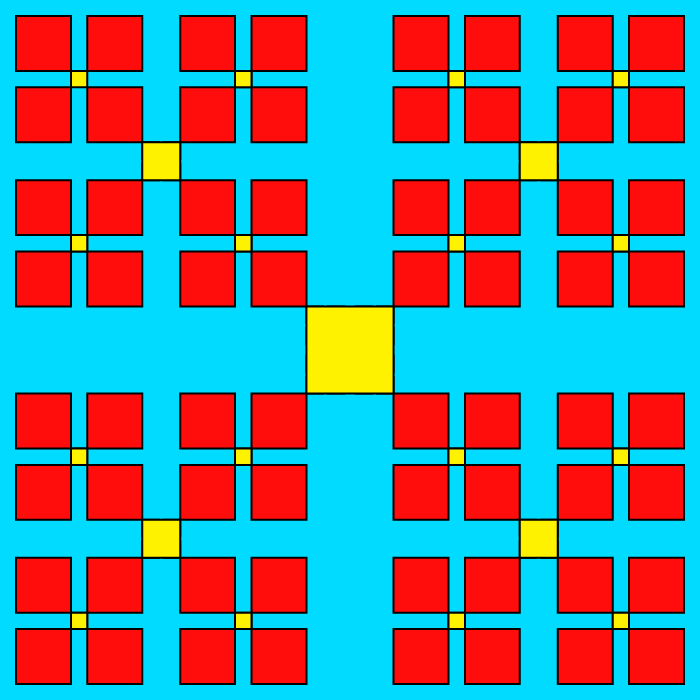
Required options
Draw a Cantor fractal with
extra squares in the center
and all squares touching
by vertices.
Reduction ratio of the square
sides between iteration steps.
Color for space fill.
Color for side dust fill.
Color for central dust fill.
Color for dust outline.
Dust outline width.
Number of iterative steps.
Space width.
Space height.
Extra space around all dust.
Pro tips
Master online fractal tools
You can pass options to this tool using their codes as query arguments and it will automatically compute output. To get the code of an option, just hover over its icon. Here's how to type it in your browser's address bar. Click to try!
https://onlinefractaltools.com/draw-cantor-dust-fractal?&width=600&height=600&iterations=4&background-color=%23fff641&line-segment-color=%231e4200&fill-color=%2309de02&line-width=4&padding=15&dust=true&ratio=3
All fractal tools
Quickly draw a custom McWorter dendrite fractal.
Quickly draw a custom canopy tree fractal.
Quickly draw a custom Gosper fractal.
Quickly draw a custom Z-order fractal.
Quickly draw a custom Hilbert fractal.
Quickly draw a custom binary v-fractal.
Quickly draw a custom Peano fractal.
Quickly draw a custom Heighway dragon fractal.
Quickly draw a custom twin dragon Heighway fractal.
Quickly draw a custom Heighway nonadragon fractal.
Quickly draw a custom Koch fractal.
Quickly draw a custom triflake fractal.
Quickly draw a custom Sierpinski triangle fractal.
Quickly draw a custom Sierpinski pentagon fractal.
Quickly draw a custom Sierpinski hexagon fractal.
Quickly draw a custom Sierpinski polygon fractal.
Quickly draw a custom Moore fractal.
Quickly draw a custom Cantor comb fractal.
Quickly draw a custom Cantor dust fractal.
Quickly draw a custom Levy fractal curve.
Quickly draw a custom ice fractal.
Quickly draw a custom Pythagoras tree fractal.
Quickly draw a custom t-square fractal.
Quickly draw a custom Hausdorff tree fractal.
Coming soon
These fractal tools are on the way
Generate a Hilbert Sequence
Walk the Hilbert fractal and enumerate its coordinates.
Generate a Peano Sequence
Walk the Peano fractal and enumerate its coordinates.
Generate a Moore Sequence
Walk the Moore fractal and enumerate its coordinates.
Generate a Hilbert String
Encode the Hilbert fractal as a string.
Generate a Peano String
Encode the Peano fractal as a string.
Generate a Moore String
Encode the Moore fractal as a string.
Generate a Cantor String
Encode the Cantor set as a string.
Generate a Dragon String
Encode the Heighway Dragon as a string.
Generate a Sierpinski String
Encode the Sierpinski fractal as a string.
Sierpinski Pyramid
Generate a Sierpinski tetrahedron (tetrix) fractal.
Cantor's Cube
Generate a Cantor's cube fractal.
Menger Sponge
Generate a Sierpinski-Menger fractal.
Jerusalem Cube
Generate a Jerusalem cube fractal.
Mosely Snowflake
Generate a Jeaninne Mosely fractal.
Mandelbrot Tree
Generate a Mandelbrot tree fractal.
Barnsey's Tree
Generate a Barnsley's tree fractal.
Barnsey's Fern
Generate a Barnsley's fern fractal.
Binary Fractal Tree
Generate a binary tree fractal.
Ternary Fractal Tree
Generate a ternary tree fractal.
Dragon Fractal Tree
Generate a dragon tree fractal.
De Rham Fractal
Generate a de Rham curve.
Takagi Fractal
Generate a Takagi-Landsberg fractal curve.
Peano Pentagon
Generate a Peano pentagon fractal curve.
Tridendrite Fractal
Generate a tridendrite fractal curve.
McWorter's Pentigree
Generate a Pentigree fractal curve.
McWorter's Lucky Seven
Generate a lucky seven fractal curve.
Eisenstein Fractions
Generate an Eisenstein fractions fractal curve.
Bagula Double V
Generate a Bagula double five fractal curve.
Julia Set
Generate a Julia fractal set.
Mandelbrot Set
Generate a Mandelbrot fractal set.
Mandelbulb Fractal
Generate a Mandelbulb fractal.
Mandelbox Fractal
Generate a Mandelbox fractal.
Buddhabrot Fractal
Generate a Buddhabrot fractal.
Burning Ship Fractal
Generate a Burning Ship fractal.
Toothpick Fractal
Generate a toothpick sequence fractal.
Ulam-Warburton Fractal
Generate an Ulam-Warburton fractal curve.
ASCII Fractal
Generate an ASCII fractal.
ANSI Fractal
Generate an ANSI fractal.
Unicode Fractal
Generate a Unicode fractal.
Emoji Fractal
Generate an emoji fractal.
Braille Fractal
Generate a braille code fractal.
Audio Fractal
Generate a fractal in audio form.
Draw a Pseudofractal
Create a fractal that looks like one but isn't a fractal.
Convert Text to a Fractal
Generate a fractal from any text.
Convert a String to a Fractal
Generate a fractal from a string.
Convert a Number to a Fractal
Generate a fractal from a number.
Merge Two Fractals
Join any two fractals together.
Draw a Random Fractal
Create a completely random fractal.
Iterate an IFS
Set up an arbitrary IFS system and iterate it.
Run IFS on an Image
Recursively transform an image using IFS rules.
Iterate an ICAF
Run infinite compositions of analytic functions.
Generate a Fractal Landscape
Create a surface that mimics a natural terrain.
Generate a Brownian Surface
Create a fractal surface via Brownian motion.
Generate a Self-similar Image
Apply fractal algorithms on your image and make it self-similar.
Find Fractal Patterns in Images
Find fractal patterns in any given image.
Find Fractal Patterns in Text
Find fractal patterns in any given text.
Find Fractal Patterns in Numbers
Find fractal patterns in any given number.
Fill a Plane with Fractals
Tessellate a plane with fractals.
Run a Cellular Automaton
Run a cellular automaton with custom rules.
Play Game of Life
Play Conway's Game of Life on an infinite grid.
Subscribe!
Never miss an update
Cool!
Notifications
We'll let you know when we add this tool
Cool!
